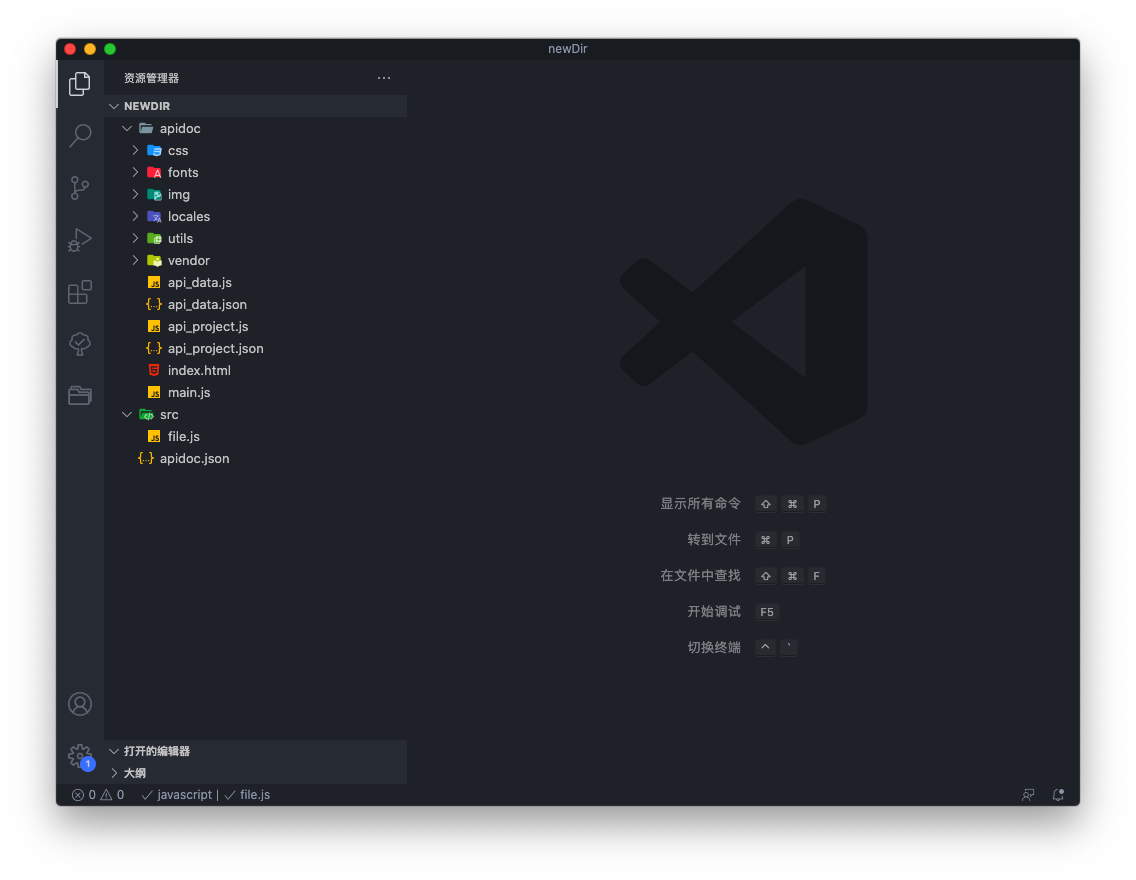apiDoc - 超简单的文档生成器,本文将讲述如何使用它。
市面上常用的 API 文档管理方式有 apiDoc、Swagger2、DocClear。
Swagger2 有一个比较明显的缺点:代码侵入,开启注解时会影响原本的系统性能。
同样 DocClear 也有一个比较明显的缺点:DocClear 本身只是一个接口信息管理平台,所有的接口信息需要开发人员在平台内进行录入。
apiDoc 作为 API 文档工具是一款通过源代码中的 API 注释创建文档,支持 Java、JS、PHP、Tython 等语言,没有 Swagger2 那样代码侵入,而是通过 apiDoc 的程序对我们的源代码文件进行扫描,获取文件内的 apiDoc 注释信息来创建 API 文档,进而生成静态的 API 文档页面。接下来就从头到尾给大家讲解一下 apiDoc 如何使用。
快速开始
装环境
新建一个项目
src/file.js,不用纠结这些注释含义, 后面会详解
1 2 3 4 5 6 7 8 9 10 11 12 13 14 15 16 17 18 19 20 21 22 function getUserInfo (username ) { }
apidoc.json
1 2 3 4 5 { "name" : "apidoc-demo" , "description" : "You write something here to describe your project" , "title" : "The title of this doc" }
执行命令,-i是指注释文件存放的地方, -o是指文档输出的位置
1 $ apidoc -i src/ -o apidoc/
接下来我们会发现多了一个文件夹**apidoc**. 这是自动生成的一个文件夹目录
双击打开index.html
如 s 上简单三步即可生成一份 API 文档, 算是挺傻瓜式的,接下来将介绍具体字段含义。
配置(apidoc.json)详解 每次导出接口文档都必须要让 apidoc 读取到 apidoc.json 文件(如果未添加配置文件,导出报错),你可以在你项目的根目录下添加 apidoc.json 文件,这个文件主要包含一些项目的描述信息,比如标题、简短的描述、版本等,你也可以加入一些可选的配置项,比如页眉、页脚、模板等。
配置项:
参数 描述
name
工程名称如果 apidoc.json 文件中没有配置该参数,apidoc 会尝试从 pakcage.json 文件中读取
version
版本如果 apidoc.json 文件中没有配置该参数,apidoc 会尝试从 pakcage.json 文件中读取
description
工程描述如果 apidoc.json 文件中没有配置该参数,apidoc 会尝试从 pakcage.json 文件中读取
title
浏览器标题
url
api 路径前缀例如:https://api.github.com/v1
sampleUrl
如果设置了该参数,那么在文档中便可以看到用于测试接口的一个表单(详情可以查看参数@apiSampleReques)
header.title
页眉导航标题
header.filename
页眉文件名(markdown) (如:header.md)
footer.title
页脚导航标题
footer.filename
页脚文件名(markdown) (如:footer.md)
order
接口名称或接口组名称的排序列表如果未定义,那么所有名称会自动排序"order": [ "Error", "Define", "PostTitleAndError", PostError"]
更多详情
apidoc 注释参数 @api 【必填字段】否则,apidoc 会忽略该条注释
1 @api {method} path [title]
参数列表:
参数
必填
描述
method
yes
请求类型:DELETE, GET, POST, PUT, ...更多
path
yes
请求路径
title
no
接口标题
例:
@apiDefine 定义注释模块(类似于代码中定义一个常量),对于一些通用可复用的注释模块(例如:接口错误响应模块),只需要在源代码中定义一次,便可以在其他注释模块中随便引用,最后在文档导出时会自动替换所引用的注释模块,定义之后您可以通过@apiUse来引入所定义的注释模块。(注:可以同时使用@apiVersion来定义注释模块的版本)
1 2 @apiDefine name [title] [description]
参数列表:
参数
必填
描述
name
yes
注释模块名称(唯一),不同@apiVersion 可以定义相同名称的注释模块
title
no
注释模块标题
description
no
注释模块详细描述(详细描述另起一行,可包含多行)
@apiDeprecated 标注一个接口已经被弃用
参数列表:
@apiDescription api 接口的详细描述
参数列表:
@apiError 错误返回参数
1 @apiError [(group)] [{type}] field [description]
参数列表:
参数
必填
描述
(group)
no
所有的参数都会通过这个参数进行分组,如果未设置,默认值为 Error 4xx
{type}
no
返回类型,例如{Boolean}, {Number}, {String}, {Object},{String[]}(字符串数组),…
field
yes
返回 id
description
no
参数描述
@apiErrorExample 接口错误返回示例(格式化输出)
1 2 @apiErrorExample [{type}] [title] example
参数列表:
参数
必填
描述
type
no
响应类型
title
yes
示例标题
example
yes
示例详情(兼容多行)
@apiExample 接口方式请求示例
1 2 @apiExample [{type}] title example
参数列表:
参数
必填
描述
type
no
请求内容格式
title
yes
示例标题
example
yes
示例详情(兼容多行)
@apiGroup 定义接口所属的接口组,虽然接口定义里不需要这个参数,但是您应该在每个接口注释里都添加这个参数,因为导出的接口文档会以接口组的形式导航展示。
参数列表:
参数
必填
描述
name
yes
接口组名称(用于导航,不支持中文)
描述接口请求头部需要的参数(功能类似@apiParam)
1 @apiHeader [(group)] [{type}] [field=defaultValue] [description]
参数列表:
参数
必填
描述
(group)
no
所有的参数都会以该参数值进行分组(默认 Parameter)
{type}
no
返回类型(例如:{Boolean}, {Number}, {String}, {Object}, {String[]})
field
yes
参数名称(定义该头部参数为必填)
[field]
yes
参数名称(定义该头部参数为可选)
=defaultValue
no
参数默认值
description
no
参数描述
请求头部参数示例
1 2 @apiHeaderExample [{type}] [title] example
参数列表:
参数
必填
描述
type
no
请求内容格式
title
no
请求示例标题
example
yes
请求示例详情(兼容多行)
@apiIgnore 如果你需要使用该参数,请把它放到注释块的最前面。如果设置了该参数,那么该注释模块将不会被解析(当有些接口还未完成或未投入使用时,可以使用该字段)
参数列表:
参数
必填
描述
hint
no
描接口忽略原因描述
@apiName 接口名称,每一个接口注释里都应该添加该字段,在导出的接口文档里会已该字段值作为导航子标题,如果两个接口的@apiVersion和@apiName一样,那么有一个接口的注释将会被覆盖(接口文档里不会展示)
参数列表:
参数
必填
描述
name
yes
接口名称(相同接口版本下所有接口名称应该是唯一的)
@apiParam 接口请求体参数
1 @apiParam [(group)] [{type}] [field=defaultValue] [description]
参数列表:
参数
必填
描述
(group)
no
所有的参数都会以该参数值进行分组(默认 Parameter)
{type}
no
返回类型(例如:{Boolean}, {Number}, {String}, {Object}, {String[]})
{type{size}}
no
返回类型,同时定义参数的范围{string{…5}}意为字符串长度不超过 5{string{2…5}}意为字符串长度介于 25 之间 {number{100-999}}意为数值介于 100999 之间
{type=allowedValues}
no
参数可选值{string=“small”}意为字符串仅允许值为”small”{string=“small”,“huge”}意为字符串允许值为”small”、“huge”{number=1,2,3,99}意为数值允许值为 1、2、3、99{string {…5}=“small”,”huge”意为字符串最大长度为 5 并且值允许为:“small”、“huge”
field
yes
参数名称(定义该请求体参数为必填)
[field]
yes
参数名称(定义该请求体参数为可选)
=defaultValue
no
参数默认值
description
no
参数描述
1 2 3 4 5 6 7 8 9 10 11 12 13 14 15 16 17 18 19 20 21 22 23
@apiParamExample 请求体参数示例
1 2 @apiParamExample [{type}] [title] example
参数列表:
参数
必填
描述
type
no
请求内容格式
title
no
请求示例标题
example
yes
请求示例详情(兼容多行)
@apiPermission 允许访问该接口的角色名称
参数列表:
参数
必填
描述
name
yes
允许访问的角色名称(唯一)
@apiPrivate 定义私有接口,对于定义为私有的接口,可以在生成接口文档的时候,通过在命令行中设置参数 --private false|true来决定导出的文档中是否包含私有接口
@apiSampleRequest 设置了该参数后,导出的 html 接口文档中会包含模拟接口请求的 form 表单;如果在配置文件apidoc.json中设置了参数sampleUrl,那么导出的文档中每一个接口都会包含模拟接口请求的 form 表单,如果既设置了sampleUrl参数,同时不希望当前这个接口包含模拟接口请求的 form 表单,可以使用@apiSampleRequest off来关闭。
参数列表:
参数
必填
描述
url
yes
模拟接口请求的 url@apiSampleRequest http://www.example.com意为覆盖apidoc.json中的sampleUrl参数,@apiSampleRequest off意为关闭接口测试功能
例:http://api.github.com/user/:id
1 2 3 4 Configuration parameter sampleUrl : "http://api.github.com"
请求发送到http://test.github.com/some_path/user/:id。
1 2 3 4 5 Configuration parameter sampleUrl : "http://api.github.com"
请求发送到http://api.github.com/test/user/:id。
1 2 3 4 5 Configuration parameter sampleUrl : "http://api.github.com"
禁用此 api 方法的 api 请求。
1 2 3 4 5 Configuration parameter sampleUrl : "http://api.github.com"
请求发送到http://api.github.com/some_path/user/:id
1 2 3 4 5 Configuration parameter sampleUrl is not set
@apiSuccess 接口成功返回参数
1 @apiSuccess [(group)] [{type}] field [description]
参数列表:
参数
必填
描述
(group)
no
所有的参数都会以该参数值进行分组,默认值:Success 200
{type}
no
返回类型(例如:{Boolean}, {Number}, {String}, {Object}, {String[]})
field
yes
返回值(返回成功码)
=defaultValue
no
参数默认值
description
no
参数描述
包含(group):
返回参数中有对象:
返回参数中有数组:
@apiSuccessExample 返回成功示例
1 2 @apiSuccessExample [{type}] [title] example
参数列表:
参数
必填
描述
type
no
返回内容格式
title
no
返回示例标题
example
yes
返回示例详情(兼容多行)
@apiUse 引入注释模块,如果当前模块定义了@apiVersion,那么版本相同或版本最近的注释模块会被引入
参数列表:
参数
必填
描述
name
yes
引入注释模块的名称
@apiVersion 定义接口/注释模块版本
参数列表:
参数
必填
描述
version
yes
版本号(支持semver 版本规范)
Tips:
把接口中的通用部分利用@apiDefine摘出来,放在一个公共文件``define.js中,之后可以利用@apiUse`去调用。
历史 api 可以存放在history.js中
生成 API 文档 当然你注释参数写好了之后它也不会帮你自动生成,你需要自己运行以下命令:
1 $ apidoc -i [项目完整路径] -o apidoc/
参数列表:
参数
描述
-c, --config指定使用的配置文件. (默认根目录的 apidoc.json apidoc.json ) 例: apidoc -c path/to/apidoc.json
-e, --exclude-filters输出文件时排除文件。 (默认: []) 例: apidoc -e node_modules
-f, --file-filtersRegEx-Filter,选择要解析的文件(可以使用许多-f)。默认.cs .dart .erl .go .java .js .php .py .rb .ts. 示例(仅解析.js 和.ts 文件): apidoc -f ".*\\.js$" -f ".*\\.ts$"
-i, --input输入/源目录名。项目文件的位置。例:apidoc -i myapp/
-o, --output输出目录名。放置生成的文档的位置,例:apidoc -o apidoc/
-t, --template使用模板输出文件。您可以创建和使用自己的模板。例:apidoc -t mytemplate/
-h, --help查看帮助文档
参考链接





